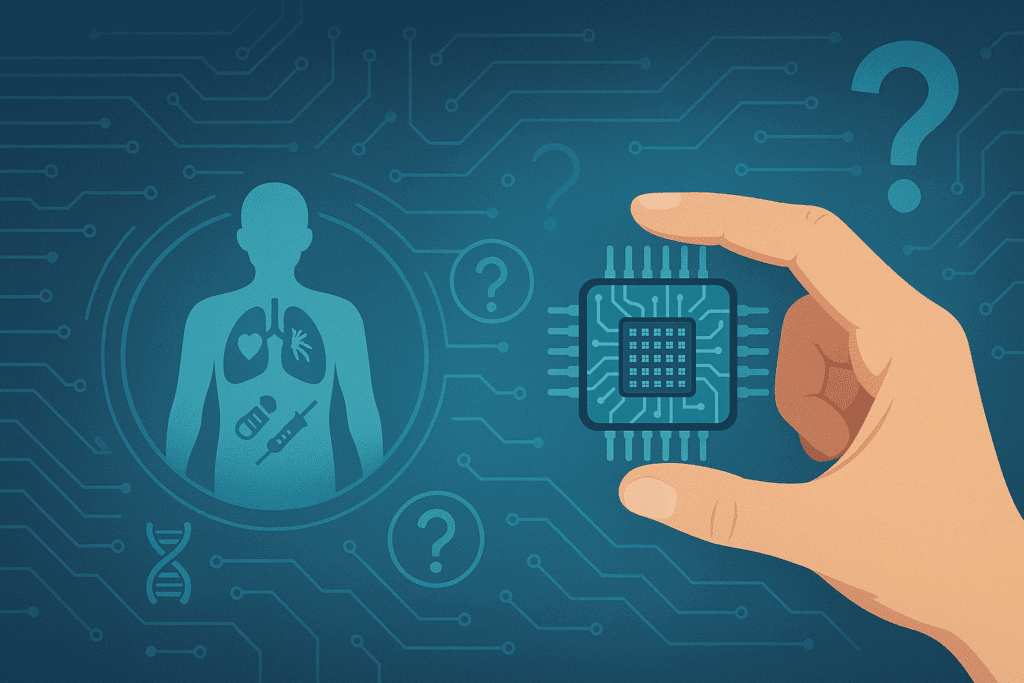“As genetic sequencing becomes faster, cheaper, and more accurate, we start seeing new ways to monitor the changing genes in a person’s body……Stephen Quake”
A single electronics card could replace everything in your wallet, including…
…Your physical cash
…Your credit cards
…Your ATM cards
…and ID cards
…Your health insurance
…and even your life
FUTURE: A Single Card or Chip Features all your Information in it
“Biochips”-The most advanced future technology is an outcome of the fields of Computer science, Electronics & Biology. It’s a new type of Bio-security device to meticulously trace information on what a person is doing. There’s a need no longer to memorize those pesky PINs, Passwords, & Social security numbers with Biochips. No more issues of taking along medical records and cash/credit cards to the hospital or marketplace; everything goes embedded in the chip. Everything is digitalized. No need for hawker cons on the internet. The biochip utilizes numerous methods to ensure E-money transactions on the net.
Components of Biochip
The current, in use, biochip implant system is a simple device. Today’s biochip implant is basically a small (micro) computer chip, inserted under the skin, for identification purposes. The biochip system is a radio frequency identification (RFID) system, using low-frequency radio signals to communicate between the biochip and reader.

The Transponder
The transponder is the actual biochip implant. It is a passive transponder, meaning it contains no battery or energy of its own. In comparison, an active transponder would provide its own energy source, normally a small battery. Because the passive biochip contains no battery, or nothing to wear out, it has a very long life, up to 99 years, and no maintenance. Being passive, it’s inactive until the reader activates it by sending it a low-power electrical charge. The reader “reads” or “scans” the implanted biochip and receives back data (in this case an identification number) from the biochip. The communication between biochip and reader is via low-frequency radio waves.
The Biochip Transponder Consists Of Four Parts:
- Computer Microchip
- Antenna Coil
- Turning Capacitor
- Glass Capsule
The Reader
The reader consists of an “exciter” coil which creates an electromagnetic field that, via radio signals, provides the necessary energy (less than 1/1000 of a watt) to “excite” or “activate” the implanted biochip. The reader also carries a receiving coil that receives the transmitted code or ID number sent back from the “activated” implanted biochip. This all takes place very fast, in milliseconds. The reader also contains the software and components to decode the received code and display the result in an LCD display. The reader can include an RS-232 port to attach a computer.
Working of a Biochip
The reader generates a low-power, electromagnetic field, in this case via radio signals, which “activates” the implanted biochip. This “activation” enables the biochip to send the ID code back to the reader via radio signals. The reader amplifies the received code, converts it to digital format, decodes and displays the ID number on the reader’s LCD display. The reader must normally be between 2 and 12 inches near the biochip to communicate. The reader and biochip can communicate through most materials, except metal.
Applications of Biochip
HealthCare
- Disease Diagnosis: Biochips are able to identify minute changes that occur in our bodies, diseases are usually detected when we get sick biochips can detect it even before it is felt clinically through auxiliary means.
- Drug testing: At times if you are trying to synthesis new medical drugs a lot of testing biochip is an example , which allows for the testing of numerous compounds in the shortest period when most steps around medical drugs is involved, and all of the outcomes are guaranteed to endure.
- Personalized medicine: All individuals possess different body types which create variable responses to medication therapy. Biochips enable medical practitioners to determine how genetic and protein characteristics influence a person’s reaction to medication. Such individual treatment methods deliver therapy with better effectiveness while diminishing the occurrence of side effects.
Biotechnology
- Research: The fundamental discovery of life requires scientists to utilize biochips for examining DNA and protein molecules. Such tools enable scientists to visualize which genes become active or inactive depending on circumstances together with protein-to-protein binding patterns. Overviews of disease development along with body functions become clearer through this research.
- Agriculture: The identification of pest-resistance and disease-resistant genes along with genes for better plant growth within plants becomes possible through biochip technology. Using biochips provides farmers the capability to cultivate crops that are both healthy and productive which becomes crucial as the human population expands.
Environmental Monitoring
Biochips function as pollution detection devices capable of identifying particular pollutants present in water or soil as well as air pollutants.
Advantages of Biochip
Biochips deliver various important advantages to users.
- The tiny design of biochips enables them to run multiple tests simultaneously through small sample and chemical requirements. Biochips provide a valuable feature for analyzing rare materials and valuable chemical substances.
- Biochips enable testers to carry out large numbers of exam results concurrently. Scientists obtain rapid access to numerous results through biochips which reduces both research time and diagnosis duration.
- Biochips achieve faster results by conducting multiple tests simultaneously because of their capacity to process several examinations simultaneously. The speed becomes a necessity for medical diagnoses when testing must be conducted under stringent time constraints.
- The design of biochips enables them to identify specific biological substances by achieving high precision levels. High accuracy diagnoses and superior biological process comprehension results from their ability to detect extremely tiny abnormalities.
- Machine operations are capable of handling numerous biochip procedures thus minimizing human mistakes while creating uniform processing protocols.
- Cost-effectiveness emerges from biochips because their capability to complete numerous tests within small material amounts becomes apparent after their initial development expenses.
- The broad functionality of biochips extends to the identification of diverse biological compounds making them ready for use across multiple applications from medical analysis to drug research and environmental assessment.
Limitations and Challenges
Biochips face specific challenges and limitations according to scientific and engineering research.

Technical Challenges
- Biochips experience difficulties in maintaining high sensitivity detection levels for minimal substance detection together with reliable test accuracy.
- The construction of Biochips presents extensive difficulties for both design and manufacturing processes. The task of designing biochips requires multiple experts from different fields and manufacturing them proves to be complicated.
- Biochip-produced information volumes often become too large for analysts to handle efficiently and understand sufficiently. A new set of computer software together with analytical algorithms must be developed to process and uncover insights from this abundant data
- Scientists encounter difficulties in developing biochips that function identically each time which hinders examination result comparison between different experiments and labs.
Ethical Considerations
- Personal information security becomes a concern when healthcare operates its biochip technology to monitor patient data. The protection and privacy of recorded data needs proper attention from developers.
- Universal access to biochip benefits is essential to preserve because the technology should serve the needs of every social class and geographic region.
Cost
- The creation along with production of biochips entails significant financial costs. Scientific experts are developing methods to reduce their costs because this will allow broader use of biochip systems.
- Scientists actively work to tackle the issues which currently exist with biochip technology development. Biochip technology will gain extended value within numerous domains because of ongoing technological advancements.
Why It Matters? The Real Impact of Biochip Technology
The scientific advancement of biochip technology functions as a transformative system-level change for healthcare operations. This article explores why biochip technology matters while describing its transformative effects on modern medical practice.
Real-Time Healthcare
Actual diagnostic methods require long delays because of sample collection processes and laboratory sending and extended test result durations. Instant analysis results are possible through biochip technology which determines harmful pathogens as well as glucose levels and genetic materials. This real-time feedback allows for:
- The preventive actions provide instantaneous life-saving opportunities.
- Monitoring of chronic conditions like diabetes, cardiovascular disease.
Personalized Medicine
Each person presents a unique medical situation amongst others. Biochips enable individualized medical care through their capability to determine specific genetic and molecular profiles of each patient. This leads to
- A personalize medicine approach and improve results.
- Targeted therapies applied to cancer treatment utilize separate treatment approaches for different patient cases.
- Basics medicine can determine ideal dosages by studying how patients’ biological systems and metabolic patterns differ from each other.
Preventive Healthcare
Biochips enable healthcare professionals to identify diseases during initial stages before their onset and in precursor phases. The healthcare process now moves from passive treatment to active prevention due to this change.
- Advanced diseases create reduced medical burdens when biochip detection systems become active.
- The long-term healthcare expenses will decrease thanks to biochips.
- Regular health monitoring enables people to achieve personal responsibility in managing their condition.
Bridging Technology and Biology
Technology establishes a strong relationship with medicine through which it effectively develops into medical applications. The integration allows for:
- The technology enables the creation of simulated organ systems for research applications during testing (organ-on-a-chip model).
- The laboratory analysis process speeds up through automated execution of complicated diagnostic protocols.
- Technological health devices such as implants and smartwatches can transmit data directly to human biological systems.
The Human Body Becomes Visible at New Levels through Understanding
The molecular operation of biochips enables scientists along with doctors to visualize disease mechanisms at their core. This leads to:
- The study of disease formation and disease advancement through new discoveries.
- Development of next-generation drugs and therapies.
- Scientific studies can achieve greater insights into human body reactions through different stimuli conditions and medical treatments.

Future of Biochip Technology in Healthcare
Fast-changing healthcare benefits enormously from biochip technology. Several amazing applications of biochip technology exist through ongoing development activities.
- Miniaturized biochips will diagnose cancer diseases and infections after analyzing only small blood drops or saliva samples. Rapid results within minutes instead of days enable patients to start receiving treatment promptly which enhances their recovery odds.
- Biochips enable doctors to determine detailed responses of specific medications on individual patients’ bodies for personalized treatment. Medical treatments can achieve optimized benefits and produce fewer side effects since they can be customized for individual patients.
- Scientists plan to produce compact biosensors which medical professionals will embed inside the body for continuous healthcare monitoring of blood sugar levels and heart procedures. Individuals living with diabetes alongside heart disease patients can benefit from biochips to monitor their health and avoid dangerous medical emergencies.
- The investigations of new drugs would benefit from biochip technology which would accelerate drug development. The quick evaluation of how possible drugs affect cell and tissue responses through biochip sensors would enable scientists to create new disease treatments including those for Alzheimer’s disease and HIV.
- Users can now perform complete laboratory testing through tiny microchip-based platforms in both medical facilities as well as their personal homes. Healthcare delivery becomes more accessible because biochip technologies lead to increased convenience which benefits people living in remote areas.
Conclusion
The healthcare field undergoes transformation through biochip technology because it makes possible earlier disease recognition in addition to customized treatment and live patient monitoring. The resolution of challenges involving cost and complexity along with ethical issues is enabling biochip technology to advance toward increased efficiency and better accessibility. The technology implements proactive healthcare methods to serve individual patients and other scientific domains.

 Medically reviewed by
Medically reviewed by